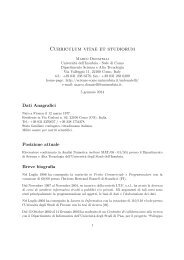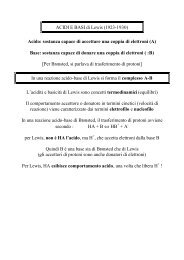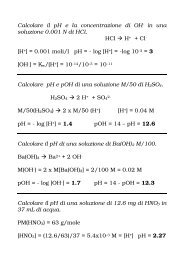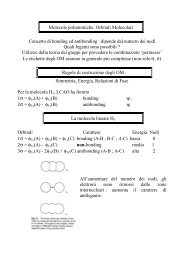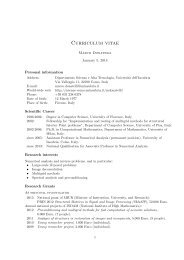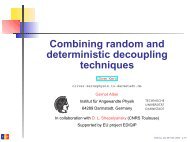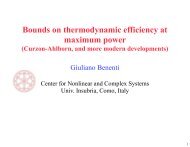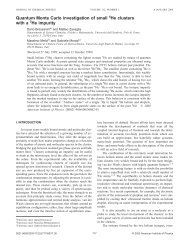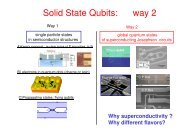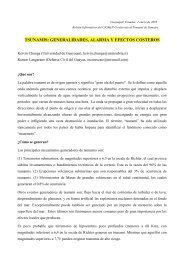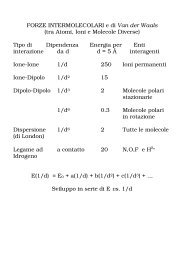Generalized variational principle for excited states using nodes of ...
Generalized variational principle for excited states using nodes of ...
Generalized variational principle for excited states using nodes of ...
You also want an ePaper? Increase the reach of your titles
YUMPU automatically turns print PDFs into web optimized ePapers that Google loves.
PHYSICAL REVIEW E 84, 046705 (2011)<br />
<strong>Generalized</strong> <strong>variational</strong> <strong>principle</strong> <strong>for</strong> <strong>excited</strong> <strong>states</strong> <strong>using</strong> <strong>nodes</strong> <strong>of</strong> trial functions<br />
Dario Bressanini *<br />
Dipartimento di Scienze Chimiche e Ambientali, Università dell’Insubria, Via Lucini 3, I-22100 Como, Italy<br />
Peter J. Reynolds †<br />
Physics Division, Army Research Office, P.O. Box 12211, Research Triangle Park, North Carolina 27709, USA<br />
(Received 14 June 2011; revised manuscript received 1 August 2011; published 18 October 2011)<br />
The familiar <strong>variational</strong> <strong>principle</strong> provides an upper bound to the ground-state energy <strong>of</strong> a given Hamiltonian.<br />
This allows one to optimize a trial wave function by minimizing the expectation value <strong>of</strong> the energy. This approach<br />
is also trivially generalized to <strong>excited</strong> <strong>states</strong>, so that given a trial wave function <strong>of</strong> a certain symmetry, one can<br />
compute an upper bound to the lowest-energy level <strong>of</strong> that symmetry. In order to generalize further and build<br />
an upper bound <strong>of</strong> an arbitrary <strong>excited</strong> state <strong>of</strong> the desired symmetry, a linear combination <strong>of</strong> basis functions<br />
is generally used to generate an orthogonal set <strong>of</strong> trial functions, all bounding their respective <strong>states</strong>. However,<br />
sometimes a compact wave-function <strong>for</strong>m is sought, and a basis-set expansion is not desirable or possible.<br />
Here we present an alternative generalization <strong>of</strong> the <strong>variational</strong> <strong>principle</strong> to <strong>excited</strong> <strong>states</strong> that does not require<br />
explicit orthogonalization to lower-energy <strong>states</strong>. It is valid <strong>for</strong> one-dimensional systems and, with additional<br />
in<strong>for</strong>mation, to at least some n-dimensional systems. This generalized <strong>variational</strong> <strong>principle</strong> exploits in<strong>for</strong>mation<br />
about the nodal structure <strong>of</strong> the trial wave function, giving an upper bound to the exact energy without the need<br />
to build a linear combination <strong>of</strong> basis functions. To illustrate the theorem we apply it to a nontrivial example: the<br />
1s2s 1 S <strong>excited</strong> state <strong>of</strong> the helium atom.<br />
DOI: 10.1103/PhysRevE.84.046705<br />
PACS number(s): 02.70.Ss, 03.65.Ge<br />
I. INTRODUCTION<br />
One <strong>of</strong> the most powerful methods <strong>for</strong> obtaining highly<br />
accurate approximate solutions to the Schrödinger equation is<br />
based on the <strong>variational</strong> <strong>principle</strong><br />
〈 H ˆ 〉= 〈| H ˆ |〉<br />
E 0 , (1)<br />
〈|〉<br />
where Hˆ<br />
is the Hamiltonian operator <strong>of</strong> the system we wish<br />
to study, E 0 is the lowest-energy eigenvalue, and is any<br />
trial wave function <strong>of</strong> the correct symmetry. In its simplest<br />
<strong>for</strong>m, the <strong>variational</strong> method consists <strong>of</strong> choosing a physically<br />
motivated trial wave function that depends on one or more<br />
adjustable parameters and then minimizing the expectation<br />
value in Eq. (1) by varying the parameters in the trial function.<br />
Within the flexibility <strong>of</strong> the trial function, this minimum is the<br />
best upper bound to the unknown ground-state energy.<br />
The above method can also be applied readily to optimize<br />
the lowest eigenstate <strong>of</strong> a given symmetry simply by constraining<br />
to be <strong>of</strong> the desired symmetry. However, if the state <strong>of</strong><br />
interest is an <strong>excited</strong> state having the same symmetry as a<br />
lower state, there is no longer a guarantee that the expectation<br />
value <strong>of</strong> the Hamiltonian will be an upper bound to the exact<br />
eigenvalue. In this case one must resort to what is sometimes<br />
called the linear <strong>variational</strong> <strong>principle</strong> (LVP). Implementation<br />
<strong>of</strong> the LVP requires that a basis set <strong>of</strong> N independent functions<br />
ϕ i is chosen, and N trial wave functions are constructed from<br />
a linear combination <strong>of</strong> these basis functions:<br />
N∑<br />
j = c ij ϕ i . (2)<br />
* dario.bressanini@uninsubria.it<br />
† peter.reynolds@us.army.mil<br />
i=1<br />
The coefficients c ij can then be determined by solving the<br />
secular linear equations<br />
N∑<br />
i=1<br />
c ij (〈ϕ j | ˆ H |ϕ i 〉−ε j 〈ϕ j |ϕ i 〉) = 0, j = 1,2,...,N. (3)<br />
Nontrivial solutions to Eq. (3) exist if and only if the secular<br />
determinant vanishes, namely,<br />
det |H − εS| =0, (4)<br />
where H is the Hamiltonian matrix with elements H ij =<br />
〈ϕ i | H ˆ |ϕ j 〉 and S is the overlap matrix with elements S ij =<br />
〈ϕ i |ϕ j 〉.<br />
According to the MacDonald-Hylleraas-Undheim theorem<br />
[1,2], the resulting ordered set <strong>of</strong> N roots ε i <strong>of</strong> the secular<br />
determinant are upper bounds to the corresponding lowest-N<br />
eigenvalues <strong>of</strong> the Hamiltonian. Furthermore, these approximate<br />
eigenvalues approach the exact eigenvalues monotonically<br />
as the basis set is increased. In this way, <strong>using</strong> a collection<br />
<strong>of</strong> basis functions, it is possible to build an upper bound to<br />
the desired <strong>excited</strong> state. What has been lost is the ability to<br />
construct a simple trial wave function with a simple physical<br />
interpretation.<br />
It would be desirable to have a generalized <strong>variational</strong><br />
<strong>principle</strong> with the property that, given an arbitrary trial<br />
wave function approximating the desired state, it could be<br />
possible to extract an upper bound to the exact energy <strong>of</strong><br />
the state without the necessity <strong>of</strong> resorting to the above<br />
basis-set expansion method. It is the purpose <strong>of</strong> this paper<br />
to show such a generalization. We prove the generalization <strong>for</strong><br />
one-dimensional problems by taking advantage <strong>of</strong> in<strong>for</strong>mation<br />
on the nodal structure <strong>of</strong> wave functions. Furthermore,<br />
we show how in some cases this can be generalized to<br />
1539-3755/2011/84(4)/046705(4) 046705-1<br />
©2011 American Physical Society
DARIO BRESSANINI AND PETER J. REYNOLDS PHYSICAL REVIEW E 84, 046705 (2011)<br />
higher-dimensional systems if additional in<strong>for</strong>mation on the<br />
nodal structure <strong>of</strong> the specific system under study is available.<br />
II. THEORY<br />
Consider the spectrum <strong>of</strong> a one-dimensional (1D) Hamiltonian<br />
Hφ ˆ n = E n φ n , n = 0,1,2,.... (5)<br />
It is well known [3] that <strong>for</strong> 1D Hamiltonians the so-called<br />
nodal theorem holds, i.e., the ground state has no <strong>nodes</strong> and a<br />
nondegenerate Mth <strong>excited</strong> state has exactly M <strong>nodes</strong>, dividing<br />
the real axis into M + 1 regions i , which are usually called<br />
nodal regions or nodal domains.<br />
Consider now a trial function approximating the exact<br />
Mth <strong>excited</strong> state. This trial function must have M <strong>nodes</strong>, but<br />
it need not be a linear combination <strong>of</strong> basis functions. Let<br />
us introduce the expectation values <strong>of</strong> the Hamiltonian within<br />
each nodal region i ,<br />
〈 H ˆ 〉 i = E i = 〈| H ˆ |〉 i<br />
〈|〉 i<br />
≡ H i<br />
S i<br />
. (6)<br />
The subscript indicates that the integration has been per<strong>for</strong>med<br />
only over the region i . It is easy to see that the full expectation<br />
value <strong>of</strong> the Hamiltonian over the whole space is a weighted<br />
average <strong>of</strong> the expectation values <strong>of</strong> the different nodal regions<br />
〈 H ˆ 〉= 〈| H ˆ |〉<br />
=<br />
〈|〉<br />
∑ M+1<br />
i<br />
〈| ˆ H |〉 i<br />
∑M+1<br />
i<br />
〈|〉 i<br />
=<br />
∑ M+1<br />
i<br />
S i E i<br />
∑M+1 .<br />
i<br />
S i<br />
For a generic <strong>excited</strong> state, the expectation value [Eq. (7)]<br />
can be above or below the exact eigenvalue. We now will<br />
prove the following theorem, which is a generalization <strong>of</strong> the<br />
ground-state <strong>variational</strong> <strong>principle</strong> in one dimension.<br />
<strong>Generalized</strong> <strong>variational</strong> <strong>principle</strong>. Given a 1D trial<br />
wave function with M <strong>nodes</strong>, the maximum <strong>of</strong> the<br />
energies〈 H ˆ 〉 i <strong>of</strong> the nodal regions is an upper bound to the<br />
energy <strong>of</strong> the Mth <strong>excited</strong> state.<br />
To prove this result we construct a basis set <strong>of</strong> M + 1<br />
auxiliary functions f i ,<br />
{ (x), x ∈ i<br />
f i (x) =<br />
(8)<br />
0, x /∈ i ,<br />
which are extracted piecewise out <strong>of</strong> the original trial wave<br />
function. Each f i is equal to the original wave function within<br />
the nodal region i and zero outside.<br />
Since the nodal regions do not overlap it is easy to show<br />
that<br />
〈f i | f j 〉=0, 〈f i |f i 〉=〈|〉 i = S i (9)<br />
and<br />
〈f i | ˆ H |f j 〉=0,<br />
(7)<br />
〈f i | ˆ H |f i 〉=〈| ˆ H |〉 i = H i . (10)<br />
The latter integrals involving the Hamiltonian must be treated<br />
with care since there is a derivative discontinuity <strong>of</strong> the wave<br />
function at the boundaries <strong>of</strong> the nodal regions and this<br />
produces a δ function. However, since the functions f i are<br />
zero at their boundaries, the contribution to these integrals is<br />
zero. More rigorously, we can take the limit <strong>of</strong> the integrals,<br />
moving the boundaries from inside the nodal region up to the<br />
<strong>nodes</strong>, and one indeed gets zero contribution.<br />
In order to prove the theorem, let us now build a trial<br />
function with the basis set just constructed and call it T<br />
to distinguish it from the original:<br />
T =<br />
M+1<br />
∑<br />
i=1<br />
c i f i . (11)<br />
Of course, if we take all the coefficients to be unity, we recover<br />
the original trial function. However, we can instead return to<br />
the <strong>for</strong>malism <strong>of</strong> Eq. (3) and optimize the linear coefficients<br />
c i by solving the secular determinant <strong>of</strong> Eq. (4). Given the<br />
orthogonality <strong>of</strong> the above basis functions,<br />
∣ H 1 − εS 1 0 ··· 0 ∣∣∣∣∣∣∣∣ 0 H 2 − εS 2 ··· 0<br />
= 0.<br />
··· ··· ··· 0<br />
∣ 0 0 0 H M+1 − εS M+1<br />
The solutions <strong>of</strong> this equation are trivially<br />
(12)<br />
ε i = H i<br />
=〈H 〉 i . (13)<br />
S i<br />
In other words, the eigenvalues are equal to the expectation<br />
values <strong>of</strong> the Hamiltonian within each nodal region. By<br />
the MacDonald-Hylleraas-Undheim theorem, the ordered set<br />
<strong>of</strong> these values are the upper bounds <strong>of</strong> the corresponding<br />
eigenvalues <strong>of</strong> the Hamiltonian. Since we are interested in the<br />
Mth state, this means that the largest eigenvalue is an upper<br />
bound 1 to the Mth state, i.e.,<br />
max〈H 〉 i E M . (14)<br />
i<br />
This completes the pro<strong>of</strong>. Note that if we start with a positiveeverywhere<br />
wave function, we recover the usual ground-state<br />
<strong>variational</strong> <strong>principle</strong>.<br />
To apply the generalized <strong>variational</strong> <strong>principle</strong>, we need<br />
a method to specify the <strong>nodes</strong>, or otherwise be able to<br />
distinguish different nodal regions, in order to compute the<br />
expectation value <strong>of</strong> the Hamiltonian in each nodal region. For<br />
one-dimensional systems this is usually easy.<br />
III. METHOD<br />
To illustrate the theorem, let us consider the 2s state <strong>of</strong><br />
the hydrogen atom. Note that, <strong>for</strong> a spherically symmetric<br />
state, after the integration <strong>of</strong> the angular coordinates the<br />
three-dimensional problem reduces to a one-dimensional one.<br />
The trial wave function = (1 − ar)e −br has two nodal<br />
domains, as needed to get the first <strong>excited</strong> state. We note<br />
that this <strong>for</strong>m has sufficient flexibility to correctly describe,<br />
<strong>for</strong> different values <strong>of</strong> the parameters a and b, both the 1s and<br />
2s <strong>states</strong>. However, the standard <strong>variational</strong> <strong>principle</strong> cannot<br />
1 It also means that the ith eigenvalue is an upper bound to the<br />
ith state. However, these lower eigen<strong>states</strong> will in general be poor<br />
bounds. Better ones can be constructed as described here, <strong>using</strong> the<br />
proper number <strong>of</strong> <strong>nodes</strong> <strong>for</strong> the state <strong>of</strong> interest.<br />
046705-2
GENERALIZED VARIATIONAL PRINCIPLE FOR EXCITED ... PHYSICAL REVIEW E 84, 046705 (2011)<br />
guarantee that the expectation value <strong>of</strong> the energy <strong>of</strong> the above<br />
function is an upper bound to the 2s energy, only that it is an<br />
upper bound to the 1s energy. This failure <strong>of</strong> the standard<br />
<strong>variational</strong> <strong>principle</strong> is because the 2s state has the same<br />
symmetry as the ground state. Since our trial function has<br />
a spherical node with radius r = 1/a, it is easy to analytically<br />
compute the two nodal expectation values, corresponding to<br />
the two nodal regions: 0 < r < 1/a and r > 1/a. By our<br />
theorem, the larger <strong>of</strong> the two must be an upper bound to the<br />
exact energy <strong>of</strong> the 2s state, namely, −0.125 a.u. This is indeed<br />
easy to show with some algebra. It produces the exact energy<br />
when b = 1/2 and a = 1/2, where the two regions produce<br />
the same result.<br />
For higher-dimensional systems, the nodal theorem on<br />
which our pro<strong>of</strong> relies is no longer valid. Courant [3] was<br />
able to prove a weaker version: The <strong>nodes</strong> <strong>of</strong> the Mth <strong>excited</strong><br />
state divide the space into at most M + 1 nodal domains.<br />
This immediately shows that generalizing our theorem to<br />
higher-dimensional systems is not straight<strong>for</strong>ward. The Mth<br />
<strong>excited</strong> state does not in general have M + 1 nodal regions,<br />
which means that we might not have M + 1 basis functions as<br />
needed to apply the MacDonald-Hylleraas-Undheim theorem.<br />
However, we will show that if additional in<strong>for</strong>mation about the<br />
nodal structure is available, the theorem can still be applied.<br />
To see how this can be done, let us consider a nontrivial<br />
example that cannot be reduced to a one-dimensional problem,<br />
namely, the 1s2s 1 S <strong>excited</strong> state <strong>of</strong> the helium atom. As in our<br />
earlier example, being an <strong>excited</strong> state <strong>of</strong> the same symmetry<br />
as the ground state means that the usual <strong>variational</strong> <strong>principle</strong><br />
is not able to give an upper bound. Nevertheless, we can<br />
successfully exploit our nodal <strong>variational</strong> <strong>principle</strong> here. We<br />
choose to describe the 1s2s state with the physically descriptive<br />
and compact trial wave function<br />
= ( ( )<br />
r1 2 + r2 2 − k2) (e −2r 1−br 2<br />
+ e −2r r12<br />
2−br 1<br />
/2<br />
)exp<br />
.<br />
1 + dr 12<br />
(15)<br />
This choice is motivated by the success <strong>of</strong> the hyperspherical<br />
treatment <strong>of</strong> the helium atom. However, other simple <strong>for</strong>ms<br />
may be chosen as well.<br />
The exact shape <strong>of</strong> the node <strong>of</strong> the 1s2s 1 S eigenstate is<br />
unknown [4]. However, the trial function above has a single<br />
nodal hypersphere <strong>of</strong> hyperradius R 2 = r 2 1 + r2 2 = k2 dividing<br />
the space into two nodal regions. Note that the trial wave<br />
function [Eq. (15)] was chosen to satisfy all cusp conditions<br />
and that the parameters b and d have no impact on the node.<br />
The position <strong>of</strong> the node is determined entirely by the choice <strong>of</strong><br />
the constant k. Note that <strong>for</strong>mally [see Eq. (8)] we will be <strong>using</strong><br />
two trial wave functions built out <strong>of</strong> the in Eq. (15): outer ,<br />
considering only the region where R>k, and similarly inner ,<br />
where R
DARIO BRESSANINI AND PETER J. REYNOLDS PHYSICAL REVIEW E 84, 046705 (2011)<br />
To show that our result <strong>for</strong> D>1 is not an artifact <strong>of</strong> our<br />
choice <strong>of</strong> Eq. (15), we consider a more sophisticated correlated<br />
wave function built <strong>using</strong> hydrogenic orbitals multiplied by a<br />
Jastrow factor<br />
( )<br />
r12 /2<br />
[1s(r 1 )2s(r 2 ) + 1s(r 2 )2s(r 1 )] exp<br />
, (16)<br />
1 + dr 12<br />
where 1s(r) = e −2r and 2s(r) = (r − c)e −br . The shape <strong>of</strong> the<br />
node is no longer a hypersphere, but one can still distinguish<br />
two nodal regions, one where the wave function is positive and<br />
the other where the wave function is negative. As be<strong>for</strong>e, an<br />
upper bound to the exact energy can be similarly extracted.<br />
We optimized the latter wave function by hand, and by <strong>using</strong><br />
the generalized <strong>variational</strong> <strong>principle</strong> obtained an upper bound<br />
<strong>of</strong> −2.1423 a.u. It would be possible to employ a still more<br />
sophisticated wave function to obtain a still better upper bound.<br />
FIG. 1. Full <strong>variational</strong> and nodal energies <strong>for</strong> the 1s2s 1 S <strong>excited</strong><br />
state <strong>of</strong> the helium atom, with the trial function described in the<br />
text, <strong>for</strong> different values <strong>of</strong> k. The solid horizontal line indicates<br />
the exact energy. The bold line indicates the total VMC energy, the<br />
long-dashed and short-dashed lines indicate, respectively, the VMC<br />
energy <strong>of</strong> the outer and inner nodal cells. Unlike the full VMC energy,<br />
which plummets at large k and fails to be <strong>variational</strong> in this situation,<br />
the larger valued <strong>of</strong> the two broken curves always lies above the<br />
horizontal line, thereby satisfying the generalized <strong>principle</strong>.<br />
Having used our <strong>variational</strong> <strong>for</strong>malism, we step back to<br />
note that the wave function in Eq. (15) could have been<br />
treated, in <strong>principle</strong>, by the MacDonald-Hylleraas-Undheim<br />
theorem because it can be cast into a linear combination <strong>of</strong><br />
two basis functions. In practice, however, this would require<br />
the computation <strong>of</strong> the relevant matrix elements that are not<br />
available in analytical <strong>for</strong>m <strong>for</strong> an explicitly correlated wave<br />
function such as this one. Moreover, with our <strong>for</strong>malism,<br />
we need not be restricted to wave functions that can be<br />
decomposed in this way.<br />
IV. CONCLUSION<br />
The properties <strong>of</strong> the nodal structure <strong>of</strong> wave functions<br />
are important in many different fields, ranging, e.g., from<br />
the study <strong>of</strong> quantum dots to the fixed node diffusion Monte<br />
Carlo method and from the quantum Hall effect to quantum<br />
chaos. Despite the fundamental importance <strong>of</strong> wave-function<br />
<strong>nodes</strong> (as opposed to orbital <strong>nodes</strong>), only recently have a few<br />
studies [4,7–12] begun to investigate the properties <strong>of</strong> <strong>nodes</strong><br />
<strong>of</strong> both exact and approximate wave functions. In this paper<br />
we presented a theorem that actually exploits the <strong>nodes</strong> and<br />
could potentially be useful in many diverse fields. We have<br />
shown that in<strong>for</strong>mation about the nodal structure <strong>of</strong> the wave<br />
function can be exploited in a <strong>variational</strong> <strong>principle</strong> that is<br />
able to give an upper bound <strong>of</strong> an arbitrary <strong>excited</strong> state <strong>of</strong><br />
a 1D system. Straight<strong>for</strong>wardly, the theorem does not hold<br />
<strong>for</strong> an arbitrary n-dimensional system since by Courant’s<br />
theorem the Mth <strong>excited</strong> state might have fewer than M + 1<br />
nodal regions. However, we showed that the theorem could<br />
still be used in higher-dimensional systems if additional<br />
in<strong>for</strong>mation on the nodal structure is available. We illustrated<br />
the higher-dimensional method by applying it to the first<br />
<strong>excited</strong> singlet state <strong>of</strong> the helium atom.<br />
[1]J.K.L.MacDonald,Phys. Rev. 43, 830 (1933).<br />
[2] E. A. Hylleraas and B. Undheim, Z. Phys. 65, 759 (1930).<br />
[3] R. Courant and D. Hilbert, Methods <strong>of</strong> Mathematical Physics<br />
(Wiley, New York, 1953), Vol. I.<br />
[4] D. Bressanini and P. J. Reynolds, Phys. Rev. Lett. 95, 110201<br />
(2005).<br />
[5] D. Bressanini and P. J. Reynolds, Adv. Chem. Phys. 105, 37<br />
(1999).<br />
[6] G. W. F. Drake and Zong-Chao Van, Chem. Phys. Lett. 229, 486<br />
(1994).<br />
[7] D. Bressanini and G. Morosi, J. Chem. Phys. 129, 054103<br />
(2008).<br />
[8] T. C. Scott, A. Luchow, D. Bressanini, and J. D. Morgan, Phys.<br />
Rev. A 75, 060101(R) (2007).<br />
[9] L. Mitas, Phys.Rev.Lett.96, 240402 (2006).<br />
[10] M. Bajdich, L. Mitas, G. Drobny, and L. K. Wagner, Phys. Rev.<br />
B 72, 075131 (2005).<br />
[11] D. M. Ceperley, J. Stat. Phys. 63, 1237 (1991).<br />
[12] D. Bressanini, D. M. Ceperley, and P. J. Reynolds, Recent<br />
Progress in QMC (World Scientific, Singapore, 2002).<br />
046705-4



